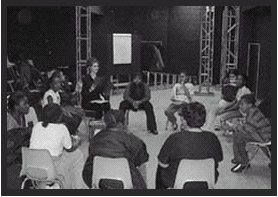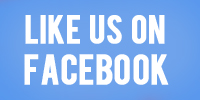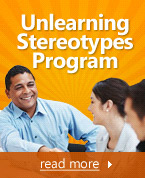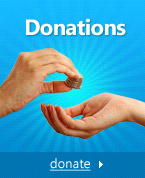About Unlearning Stereotypes — Civil Rights and Race Relations Project
 Our Unlearning Stereotypes: Civil Rights and Race Relations program is central to our strategy for fostering interracial cooperation and it has won acclaim for its success from students, professional teachers and the principals in the schools where we have placed our program. Logic, argument, discussion and mutual respect are emphasized as the basis for communicating with each other.
Our Unlearning Stereotypes: Civil Rights and Race Relations program is central to our strategy for fostering interracial cooperation and it has won acclaim for its success from students, professional teachers and the principals in the schools where we have placed our program. Logic, argument, discussion and mutual respect are emphasized as the basis for communicating with each other.
The Project offers high school-age youth alternatives to defeatism and racial fanaticism. We believe that if our youth are to identify with the processes of democracy and the principles of equality and the idea of social unity, they will need positive reinforcement in realizing these goals. They should have contact and meaningful discussions with successful, thoughtful, adult role models, and with each other—as students concerned with learning. Our educational program gives the students a weekly forum to discuss real-life issues—a place to talk about the things that concern them.
We have found that the classroom is a perfect setting for rekindling the true spirit of democracy and equality by examining the many ways that group prejudice and discrimination can hobble individual freedom. Students learn to love the program and welcome our volunteer teachers who return to the same class week after week, all semester long. That way, our volunteers (who come from all walks of life but are mostly lawyers, law students, and paralegals) establish a meaningful connection with the students and with the professional classroom teacher. The professional classroom teacher oftentimes continues discussions of issues begun in an NYCRC class. The professional teacher is retooled and reenergized, first through seeing their students’ interest in classroom discussions, and then in following up—using our techniques—in class during the course of the week. Thus, we have changed the dynamics of the classroom. Prior to our coming to the school, students were passive learners. Our methodology makes the students active and interactive learners.
The most important population served by the Unlearning Stereotypes: Civil Rights and Race Relations program is, of course, the students.
We have capsulized this effort as the students’ “D-R-E-A-M” Project”:
The “D” stands for “dialogue”. We foster dialogue across racial/ethnic barriers, among students who have never spoken to each other before, and between the volunteer teachers and the students. The program is designed to give students the opportunity to speak openly and honestly about day-to-day events that affect their lives and about larger societal problems. Our volunteers do not proselytize—the students are not lectured or taught to think or act in a particular way. Rather, through discussion and role-playing activities, they begin to understand their own opinions and that of their peers. They learn to disagree without being disagreeable and, thus, to respect each other’s views.
The “R” stands for “role models”. Role models are essential for the youth of this city, and our project not only brings to students a bi-racial, co-ed team of volunteers who work together to teach our classes, but educates students about a wide variety of historical and contemporary people from whom to choose as their own role models. For many students, seeing the bi-racial volunteer team work cooperatively on intensely-charged issues of race and bigotry provides them with a hands-on model of how to work together with their peers. At the same time, it is important for youth to learn about the wide variety of people in their local community, in the city, and in society-at-large, who have worked for social change. It is crucial that the youth of today see that they, too, can make a difference in the world in which they live.
The “E” stands for “education”. It is always surprising to learn how little students know about the history of our nation’s civil rights movement—its leaders and the hopes and goals they have for our nation’s future. NYCRC volunteers educate students about past and current events, the judicial system, and the course of our common history and destinies. Education is the key to change, to dialogue, and to better understanding the world in which we live.
The “A” stands for “activism”. In too many classrooms, students are passive in the learning process. It is important to draw them out, to engage them, to activate them. Activism comes on different levels, whether it is registering to vote, reading a book, or choosing to go further with their education. We think that the students involved in our program will become more interested in school and more active in the affairs of their neighborhood and the larger community on those concerns and issues that they engage with in class.
The “M” stands for “mechanics”. In order to change the society in which they live and become active, students must learn the mechanics of community activism and politics, i.e. how to organize; how to convince people in their community to work cooperatively on an issue affecting them; how to speak and write so as to communicate their ideas; how to negotiate the political system to work for them; and how to combat bias and discrimination in their lives. While it is important to talk to students about the problems they have and will face, it is crucial to provide them with a variety of ways in which to solve these problems. Hence, the “M” in DREAM also stands for our MISSION. It is our MISSION to fight racial idiocy and to help with the unlearning of stereotypes.
The acronym D-R-E-A-M is not simply a way of remembering the five central goals of the Civil Rights and Race Relations Program. As we succeed and accomplish the goals that we have set out to achieve we are giving youths more than just a modern education and the skills and motivation to peaceably solve problems, we are helping them to work towards and achieve their own dreams and career goals. So many want to be what they see their role models are—successful, smart, empathetic, public-spirited professionals and graduate students.
Evaluation
The program’s evaluation survey is the same as it has been since 1989; it is administered at the conclusion of each semester. It measures students’ attitudes about racial and other kinds of prejudice, as well as solicits their responses to questions about the Unlearning Stereotypes: Civil Rights and Race Relations course they just completed, and about our volunteers’ performance as discussion leaders. The surveys are confidential and filled out anonymously and form the cornerstone of our understanding of the program’s impact. However, we do not rely on the feedback of students alone. We also get feedback from the professional classroom (Department of Education) teachers; we value their feedback. Also, the volunteer teachers give us feedback during the course of the semester. From this feedback, we discern the successful teaching strategies and any problems that may occur.
The vast majority of evaluations we have received from students participating in our classes have been overwhelmingly positive. Yet, these evaluations are only part of the analysis, and reflect only a small portion of the program’s impact. It remains to be seen whether the students who have participated in our classes will, as citizens, become the role models for the next generation. We expect that some, if not many, will. That’s the measure of true social change. We have good reason to believe that students who have taken our course have a head-start on the management of diversity in their personal lives. We believe that our course has improved the chances and opportunities for integration among diverse populations of young people prior to their entrance into college and/or the work place. Moreover, we know that graduates of our program—the volunteer law students mainly—when they relocate to other cities—start copycats of our Unlearning Stereotypes program.






